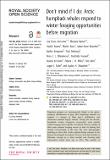Files in this item
Don’t mind if I do : Arctic humpback whales respond to winter foraging opportunities before migration
Item metadata
| dc.contributor.author | Kettemer, Lisa Elena | |
| dc.contributor.author | Ramm, Theresia | |
| dc.contributor.author | Broms, Fredrik | |
| dc.contributor.author | Biuw, Martin | |
| dc.contributor.author | Blanchet, Marie-Anne | |
| dc.contributor.author | Bourgeon, Sophie | |
| dc.contributor.author | Dubourg, Paul | |
| dc.contributor.author | Ellendersen, Anna C. J. | |
| dc.contributor.author | Horaud, Mathilde | |
| dc.contributor.author | Kershaw, Joanna | |
| dc.contributor.author | Miller, Patrick J. O. | |
| dc.contributor.author | Øien, Nils | |
| dc.contributor.author | Pallin, Logan J. | |
| dc.contributor.author | Rikardsen, Audun H. | |
| dc.date.accessioned | 2023-09-14T14:30:19Z | |
| dc.date.available | 2023-09-14T14:30:19Z | |
| dc.date.issued | 2023-09-06 | |
| dc.identifier | 293883797 | |
| dc.identifier | 2ef01f65-e632-4f63-99cf-fc8bc41e2438 | |
| dc.identifier | 85171548509 | |
| dc.identifier.citation | Kettemer , L E , Ramm , T , Broms , F , Biuw , M , Blanchet , M-A , Bourgeon , S , Dubourg , P , Ellendersen , A C J , Horaud , M , Kershaw , J , Miller , P J O , Øien , N , Pallin , L J & Rikardsen , A H 2023 , ' Don’t mind if I do : Arctic humpback whales respond to winter foraging opportunities before migration ' , Royal Society Open Science , vol. 10 , no. 9 . https://doi.org/10.1098/rsos.230069 | en |
| dc.identifier.issn | 2054-5703 | |
| dc.identifier.other | Jisc: 1319109 | |
| dc.identifier.other | publisher-id: rsos230069 | |
| dc.identifier.uri | https://hdl.handle.net/10023/28380 | |
| dc.description | The project was supported by the ‘Whalefeast project’ (financed by The Regional Research Council in Troms), and the UiT—The Arctic University of Norway and the Institute for Marine Research in Bergen. | en |
| dc.description.abstract | Migration patterns are fundamentally linked to the spatio-temporal distributions of prey. How migrating animals can respond to changes in their prey's distribution and abundance remains largely unclear. During the last decade, humpback whales (Megaptera novaeangliae) used specific winter foraging sites in fjords of northern Norway, outside of their main summer foraging season, to feed on herring that started overwintering in the area. We used photographic matching to show that whales sighted during summer in the Barents Sea foraged in northern Norway from late October to February, staying up to three months and showing high inter-annual return rates (up to 82%). The number of identified whales in northern Norway totalled 866 individuals by 2019. Genetic sexing and hormone profiling in both areas demonstrate a female bias in northern Norway and suggest higher proportions of pregnancy in northern Norway. This may indicate that the fjord-based winter feeding is important for pregnant females before migration. Our results suggest that humpback whales can respond to foraging opportunities along their migration pathways, in some cases by continuing their feeding season well into winter. This provides an important reminder to implement dynamic ecosystem management that can account for changes in the spatio-temporal distribution of migrating marine mammals. | |
| dc.format.extent | 835432 | |
| dc.language.iso | eng | |
| dc.relation.ispartof | Royal Society Open Science | en |
| dc.subject | Pregnancy rates | en |
| dc.subject | Stopover | en |
| dc.subject | Hormone profiling | en |
| dc.subject | Spatial ecology | en |
| dc.subject | Migration timing | en |
| dc.subject | Marine mammals | en |
| dc.subject | DAS | en |
| dc.subject | SDG 14 - Life Below Water | en |
| dc.title | Don’t mind if I do : Arctic humpback whales respond to winter foraging opportunities before migration | en |
| dc.type | Journal article | en |
| dc.contributor.institution | University of St Andrews. Arctic Research Centre | en |
| dc.contributor.institution | University of St Andrews. School of Biology | en |
| dc.contributor.institution | University of St Andrews. Sea Mammal Research Unit | en |
| dc.contributor.institution | University of St Andrews. Scottish Oceans Institute | en |
| dc.contributor.institution | University of St Andrews. Institute of Behavioural and Neural Sciences | en |
| dc.contributor.institution | University of St Andrews. Centre for Social Learning & Cognitive Evolution | en |
| dc.contributor.institution | University of St Andrews. Bioacoustics group | en |
| dc.contributor.institution | University of St Andrews. Marine Alliance for Science & Technology Scotland | en |
| dc.identifier.doi | 10.1098/rsos.230069 | |
| dc.description.status | Peer reviewed | en |
This item appears in the following Collection(s)
Items in the St Andrews Research Repository are protected by copyright, with all rights reserved, unless otherwise indicated.

